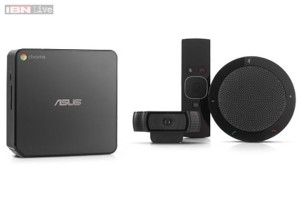 Google aims to equip meeting rooms with videoconferencing capabilities with the launch of its product for businesses, Chromebox.
Google aims to equip meeting rooms with videoconferencing capabilities with the launch of its product for businesses, Chromebox.
According to the search giant, only five to 10 percent of meeting rooms have videoconferencing. Google aims to enable the remaining 90 percent with the out-of-the-box system that comprises a speaker-microphone, HD camera, remote control and an Intel Corei7-based Chromebox device.
While Asus has been named as the manufacturer of the Chromebox, Google declined to reveal details about the makers of the other components.
The system is based on Google’s Hangouts app, and requires users to have a Google account. However, third-party applications from Vidyo and UberConference enables interoperability with other videoconferencing platforms. It is also integrated with Google Apps, in particular Google Calendar, which allows users to join meetings with a single click on an entry in the calendar.
In addition, users can join Chromebox meetings from any device, including mobiles, tablets and desktops.
“For the price of a traditional machine you can equip 10 meeting rooms with these videoconferencing capabilities,” said Mark Van Der Linden, Google Enterprise country manager for the UK.
Prices have not been confirmed for the UK market yet, but Chromebox is launching today in the US at “less than $1,000”, which includes the hardware and the cost of licences for up to 15 connections and support for 12 months. The licence and support will cost around $250 a year thereafter.
Google said that this is a “more attractive” price point, compared with existing offerings on the market.
Initial set-up is also easy, Google said, with early adopters reporting that it takes five to 10 minutes to set the devices up. The system has been tested by customers and partners, such as Premier Foods, Yelp, Costco and Eventbrite.
Meanwhile, Google was eager to appease security concerns, saying that all video data was encrypted and that it did not store any of the data.





